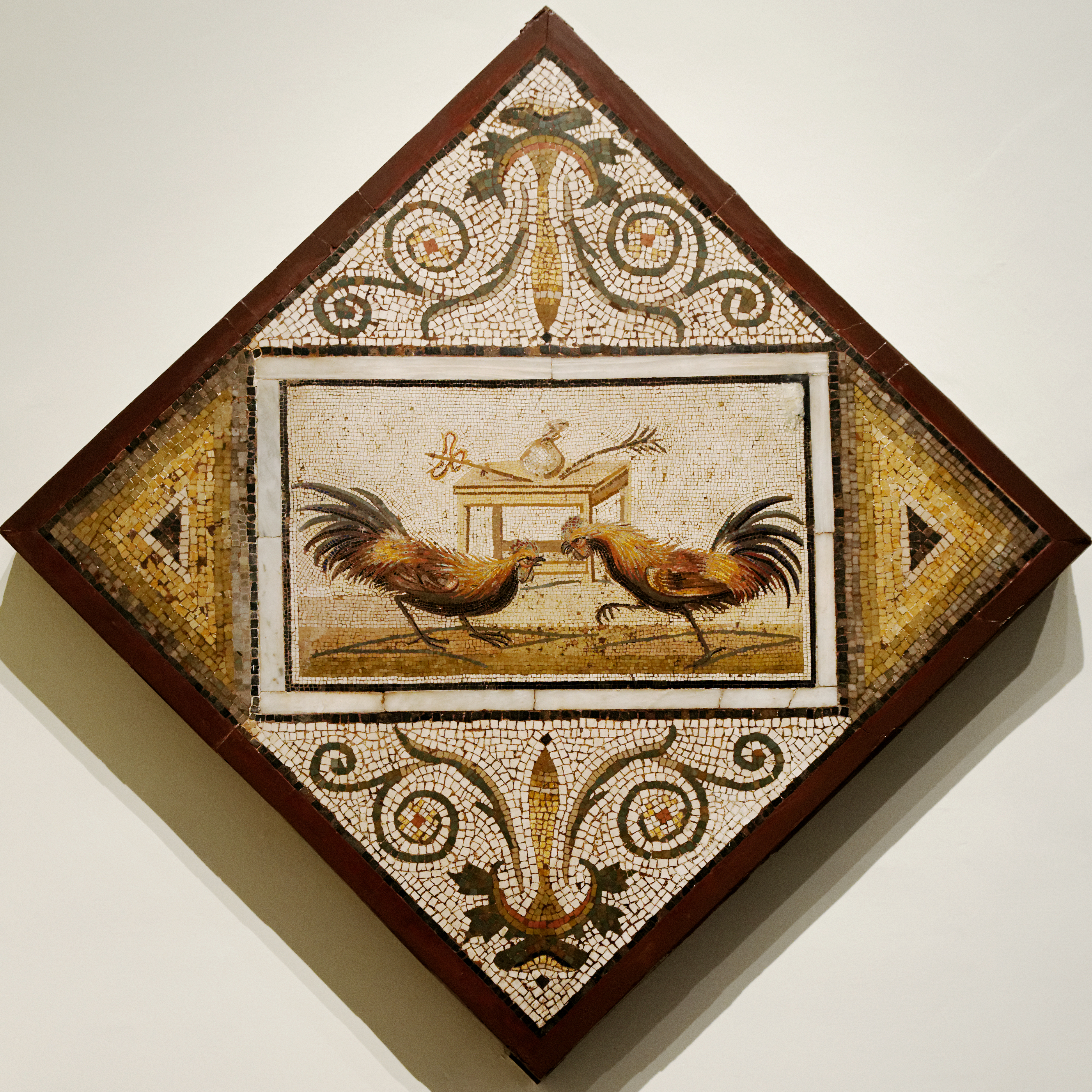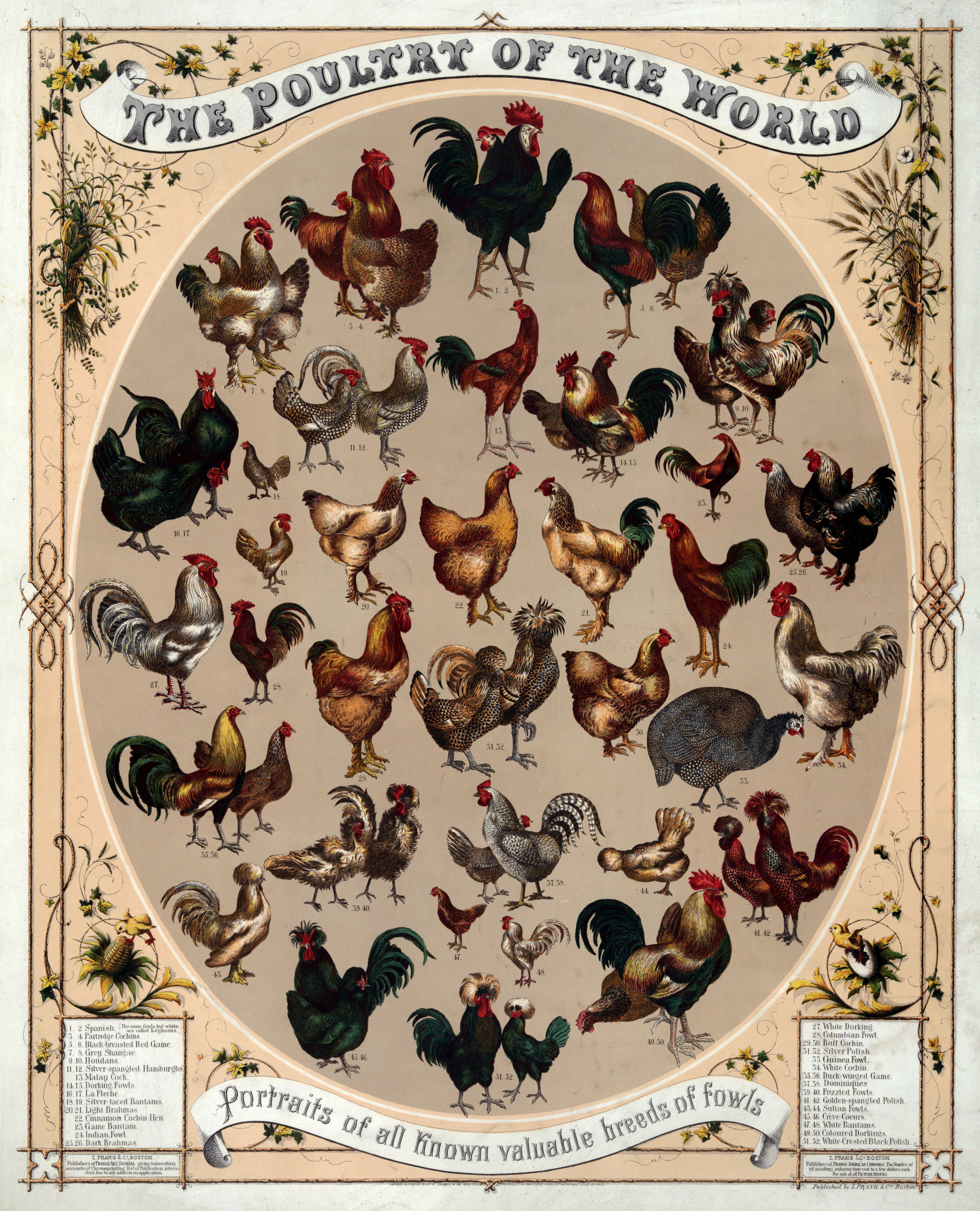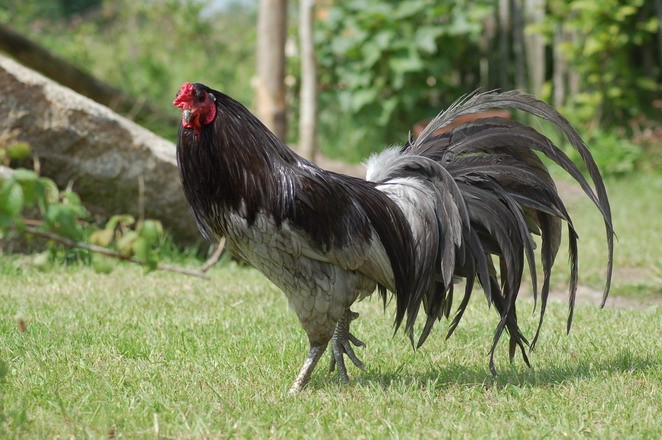|
Indian Game (poultry)
The Indian Game is a British breed of game chicken, now reared either for meat or show. It originated in the early nineteenth century in the counties of Cornwall and Devon in south-west England. It is a heavy, muscular bird with an unusually broad breast; the eggs are light brown. In the United States the name was changed in the early twentieth century to Cornish. A white variant, the White Cornish, was developed there at about the same time, and is much used in modern industrial chicken meat production in many parts of the world, either for cross-breeding to produce hybrid broilers, or to produce fast-growing " game hens". History The breed was developed by Sir Walter Gilbert, of Bodmin in Cornwall, in about 1820. It was intended to be a gamecock, but had no aptitude for cockfighting. It is recognised as "Indian Game" in Australia, by the Poultry Club of Great Britain in the United Kingdom, and by the Entente Européenne in Europe. In the United States the name wa ... [...More Info...] [...Related Items...] OR: [Wikipedia] [Google] [Baidu] |
Cockfighting
Cockfighting is a blood sport involving domesticated roosters as the combatants. The first documented use of the word gamecock, denoting use of the cock as to a "game", a sport, pastime or entertainment, was recorded in 1634, after the term "cock of the game" used by George Wilson, in the earliest known book on the sport of cockfighting in ''The Commendation of Cocks and Cock Fighting'' in 1607. But it was during Ferdinand Magellan's voyage of discovery of the Philippines in 1521 when modern cockfighting was first witnessed and documented for Westerners by the Italian Antonio Pigafetta, Magellan's chronicler, in the Kingdom of Taytay. The gamecocks (not to be confused with game birds) are specially bred and conditioned for increased stamina and strength. Male and female chickens of such a breed are referred to as gamefowl. Cocks are also bred to be aggressive towards other males of their species. Wagers are often made on the outcome of the match, held in a ring called a ... [...More Info...] [...Related Items...] OR: [Wikipedia] [Google] [Baidu] |
Entente Européenne
Entente, meaning a diplomatic "understanding", may refer to a number of agreements: History * Entente (alliance), a type of treaty or military alliance where the signatories promise to consult each other or to cooperate with each other in case of a crisis or military action * Entente Cordiale (1904) between France and the United Kingdom * Anglo-Russian Entente (1907) between the United Kingdom and Russia * Triple Entente, an informal understanding between the Russian Empire, the French Third Republic and the United Kingdom of Great Britain and Ireland, built upon the Franco-Russian Alliance (1894), the Entente Cordiale (1904), and the Anglo-Russian Entente (1907) ** Allies of World War I, sometimes referred to as "The Entente", "The Entente Powers", or "The Entente Forces" * Little Entente (1920–1938), between Czechoslovakia, Romania, and the Kingdom of Yugoslavia * Balkan Entente (1934–1938), between Greece, Turkey, Romania and Yugoslavia * Baltic Entente (1934–1939), betwe ... [...More Info...] [...Related Items...] OR: [Wikipedia] [Google] [Baidu] |
Chicken Breeds
There are hundreds of chicken breeds in existence. Domesticated for thousands of years, distinguishable breeds of chicken have been present since the combined factors of geographical isolation and selection for desired characteristics created regional types with distinct physical and behavioral traits passed on to their offspring. The physical traits used to distinguish chicken breeds are size, plumage color, comb type, skin color, number of toes, amount of feathering, egg color, and place of origin. They are also roughly divided by primary use, whether for eggs, meat, or ornamental purposes, and with some considered to be dual-purpose. In the 21st century, chickens are frequently bred according to predetermined breed standards set down by governing organizations. The first of such standards was the British Poultry Standard, which is still in publication today. Other standards include the Standard of Perfection, the Australian Poultry Standard, and the standard of the America ... [...More Info...] [...Related Items...] OR: [Wikipedia] [Google] [Baidu] |
Christie Aschwanden
Christie Aschwanden is an American journalist and the former lead science writer at ''FiveThirtyEight''. Her 2019 book ''GOOD TO GO: What the Athlete in All of Us Can Learn From the Strange Science of Recovery'', was a New York Times bestseller. She was awarded an American Association for the Advancement of Science Kavli Science Journalism Award in 2016 and serves on the board of the Council for the Advancement of Science Writing. Early life and education Aschwanden is the daughter of a United States Air Force fighter pilot. She was a high school track star. Aschwanden studied biology at the University of Colorado Boulder, where, alongside her studies, she was a professional cyclist. During her summers she interned at ScienceNOW, the web news service of the journal ''Science''. After graduating she worked as a research assistant in a laboratory in Boulder. Whilst she briefly considered applying for a doctorate, she did not want to specialize. During her time as a researcher Asch ... [...More Info...] [...Related Items...] OR: [Wikipedia] [Google] [Baidu] |
Sussex (chicken)
The Sussex is a British breed of dual-purpose chicken, reared both for its meat and for its eggs. Eight colours are recognised for both standard-sized and bantam fowl. A breed association, the Sussex Breed Club, was organised in 1903. History The Sussex originates in the historic county of Sussex, in south-east England. It is among the oldest of British chicken breeds: birds described as "Old Sussex or Kent Fowl" were shown at the first poultry show at London Zoo in 1845. The Sussex was not included in the first poultry standard, the ''Standard of Excellence in Exhibition Poultry'' of William Bernhardt Tegetmeier, in 1865. The breed standard for the Sussex was drawn up in 1902, with three colour varieties, the light, the red and the speckled. Of these, the speckled was the oldest. The development of the light variety was probably influenced by Oriental breeds such as the Brahma and Cochin, and also by the silver-grey Dorking. The red was originally black-breasted; it ... [...More Info...] [...Related Items...] OR: [Wikipedia] [Google] [Baidu] |
Orpington (chicken)
The Orpington is a British breed of chicken. It was bred in the late nineteenth century by William Cook of Orpington, at that time in Kent in south-east England. It was intended to be a dual-purpose breed, to be reared both for eggs and for meat, but soon became exclusively a show bird. The Australorp of Australia derives from it. History The original Black Orpington was bred by William Cook in the 1880s in Orpington, which at that time was in Kent in south-east England. He crossed Minorcas, Langshans and Plymouth Rocks to create a new hybrid bird. It was bred as a dual-purpose utility chicken, to be reared both for eggs and for meat; Cook chose black as a colour that would not show the soot and grime of London. He was also the breeder of the Orpington Duck. Black Orpingtons were exhibited at the Dairy Show in Islington in 1886, and also at shows in The Crystal Palace in Sydenham and in Birmingham. A separate show class was created for them in 1888. From the early 18 ... [...More Info...] [...Related Items...] OR: [Wikipedia] [Google] [Baidu] |
Dorking (chicken)
The Dorking is a British breed of domestic chicken. It is named after the town of Dorking, in Surrey in southern England. History The Dorking is among the oldest British chicken breeds. It has sometimes been suggested that it derives from five-toed (rather than the usual four-toed) chickens brought to Britain by the Romans in the first century AD, but it is not known whether the Romans brought poultry with them, nor if they found five-toed poultry when they arrived. The Roman writer Columella, active at that time, mentions five-toed hens as being the best breeding-stock: "they are reckoned the most generous which have five toes". The Dorking originated in the southern home counties in south-east England, and is named after the market town of Dorking, in Surrey, from where birds were sent to the markets of London. It was the principal meat breed supplied to the metropolis until it was displaced by the Sussex in the early part of the twentieth century; it also became popular ... [...More Info...] [...Related Items...] OR: [Wikipedia] [Google] [Baidu] |
Parasite
Parasitism is a Symbiosis, close relationship between species, where one organism, the parasite, lives (at least some of the time) on or inside another organism, the Host (biology), host, causing it some harm, and is Adaptation, adapted structurally to this way of life. The entomologist E. O. Wilson characterised parasites' way of feeding as "predators that eat prey in units of less than one". Parasites include single-celled protozoans such as the agents of malaria, sleeping sickness, and amoebic dysentery; animals such as hookworms, lice, mosquitoes, and vampire bats; fungi such as Armillaria mellea, honey fungus and the agents of ringworm; and plants such as mistletoe, dodder, and the Orobanchaceae, broomrapes. There are six major parasitic Behavioral ecology#Evolutionarily stable strategy, strategies of exploitation of animal hosts, namely parasitic castration, directly transmitted parasitism (by contact), wikt:trophic, trophicallytransmitted parasitism (by being eaten), ... [...More Info...] [...Related Items...] OR: [Wikipedia] [Google] [Baidu] |
Diseases Of Poultry
Poultry diseases occur in poultry, which are domesticated birds kept for their meat, eggs or feathers. Poultry species include the chicken, turkey, duck, goose and ostrich. Viral diseases * Avian infectious bronchitis, caused by a strain of Avian coronavirus previously known as infectious bronchitis virus * Avian infectious laryngotracheitis, caused by Gallid alphaherpesvirus 1 * Avian influenza, caused by Avian influenza virus * Duck plague, caused by Anatid alphaherpesvirus 1 * Chicken infectious anemia, caused by Chicken anaemia virus * Epidemic tremor, caused by Tremovirus * Fowlpox, caused by viruses in the genus ''Avipoxvirus'' * Infectious bursal disease (IBD), also known Gumboro disease, caused by Infectious bursal disease virus * Lymphoid leukosis caused by avian sarcoma leukosis virus * Marek's disease * Newcastle disease * Viral arthritis, caused by Avian reovirus Parasitic diseases * Scaly leg, caused by the mite ''Knemidocoptes mutans'' * Infestation by ''Derma ... [...More Info...] [...Related Items...] OR: [Wikipedia] [Google] [Baidu] |
Standard Of Perfection
The ''American Standard of Perfection'' is the official book of breed standards of the American Poultry Association. It classifies and describes the standard physical appearance, coloring and temperament for many breeds of poultry recognized in the United States, including chickens, ducks, turkeys, geese and guinea fowl, but not pigeons. The earliest book of breed standards for the poultry fancy in North America was published in 1867 as the ''Standard of Excellence'', under the auspices of the American Poultry Society; the first such work to be published by the American Poultry Association – which was constituted in 1873/1874 – was the ''American Standard of Excellence'' in 1874. History The first book of breed standards for the poultry fancy in North America was the ''Standard of Excellence'', published in 1867 under the auspices of the American Poultry Society. The full title was ''The Standard of Excellence as adopted by the American Poultry Society, being a repri ... [...More Info...] [...Related Items...] OR: [Wikipedia] [Google] [Baidu] |
Entente Européenne D'Aviculture Et De Cuniculture
The (), usually known as the or simply EE, is a European organisation of breeders of poultry, pigeons, rabbits, guinea-pigs and cage-birds. It was founded in Brussels on 18 June 1938 as the ; the founding members were from Belgium, France, Luxembourg and the Netherlands. It is now based in Luxembourg Luxembourg, officially the Grand Duchy of Luxembourg, is a landlocked country in Western Europe. It is bordered by Belgium to the west and north, Germany to the east, and France on the south. Its capital and most populous city, Luxembour .... It represents some 2.5 million members from 31 countries. It sometimes uses an alternative name: * * * European Association of Poultry, Pigeon, Cage Bird, Rabbit and Cavy Breeders. References {{reflist, 45em, refs= [...More Info...] [...Related Items...] OR: [Wikipedia] [Google] [Baidu] |
List Of Chicken Colours
{{bots, deny=Citation bot ...
Breeders and fanciers of chickens accurately describe the colours and patterns of the feathers of chicken breeds and varieties. This is a list of the terms used in this context. Self Self-coloured chickens are those which display one solid colour without patterning of any kind. Barred and cuckoo Columbian, belted Duckwing Laced Pencilled Mottled, spangled, mille fleur Black-tailed Black-breasted Others References Chickens Bird colours Chicken plumage patterns Poultry Chicken The chicken (''Gallus gallus domesticus'') is a domesticated subspecies of the red junglefowl (''Gallus gallus''), originally native to Southeast Asia. It was first domesticated around 8,000 years ago and is now one of the most common and w ... [...More Info...] [...Related Items...] OR: [Wikipedia] [Google] [Baidu] |


